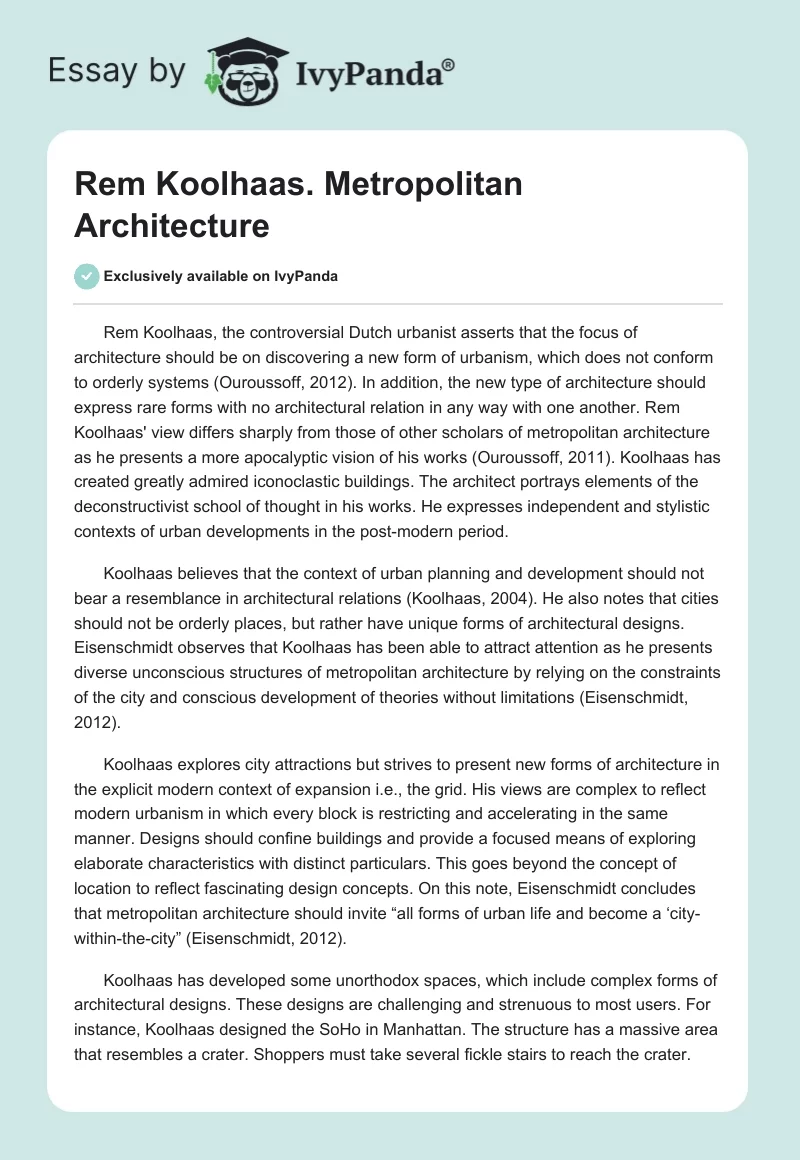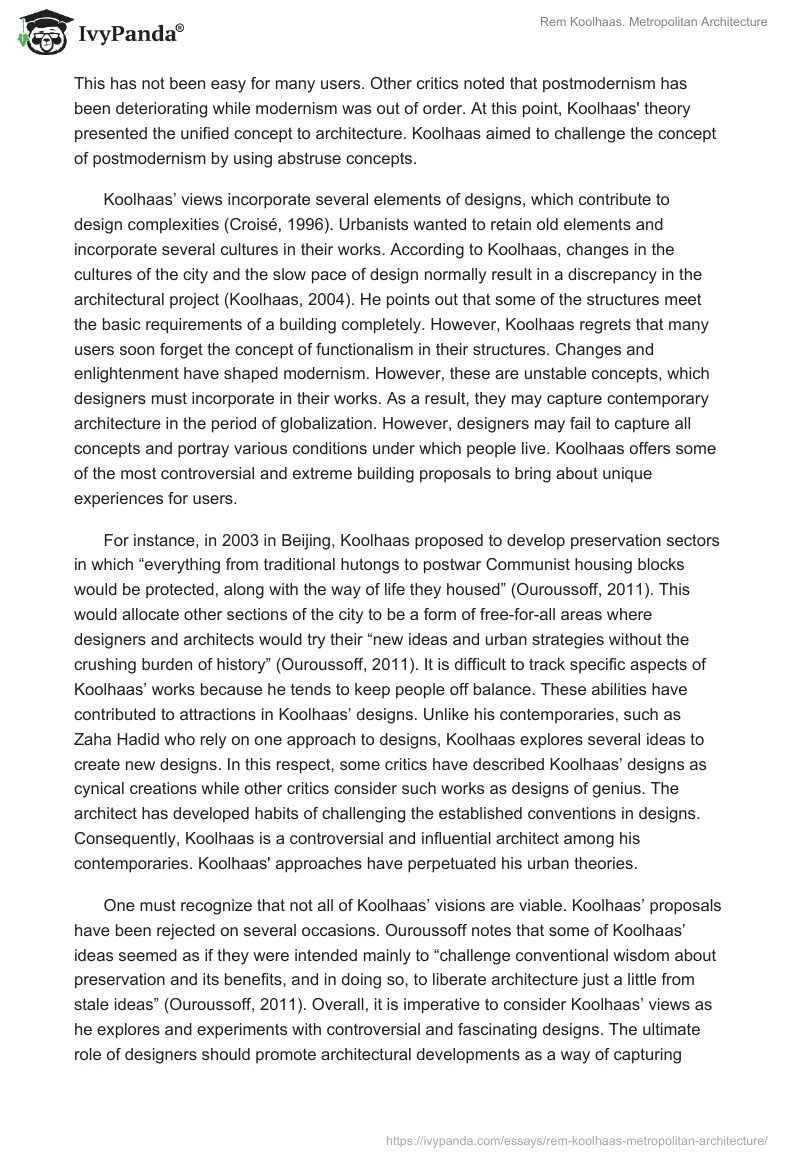Rem Koolhaas, the controversial Dutch urbanist asserts that the focus of architecture should be on discovering a new form of urbanism, which does not conform to orderly systems (Ouroussoff, 2012). In addition, the new type of architecture should express rare forms with no architectural relation in any way with one another. Rem Koolhaas’ view differs sharply from those of other scholars of metropolitan architecture as he presents a more apocalyptic vision of his works (Ouroussoff, 2011). Koolhaas has created greatly admired iconoclastic buildings. The architect portrays elements of the deconstructivist school of thought in his works. He expresses independent and stylistic contexts of urban developments in the post-modern period.
Koolhaas believes that the context of urban planning and development should not bear a resemblance in architectural relations (Koolhaas, 2004). He also notes that cities should not be orderly places, but rather have unique forms of architectural designs. Eisenschmidt observes that Koolhaas has been able to attract attention as he presents diverse unconscious structures of metropolitan architecture by relying on the constraints of the city and conscious development of theories without limitations (Eisenschmidt, 2012).
Koolhaas explores city attractions but strives to present new forms of architecture in the explicit modern context of expansion i.e., the grid. His views are complex to reflect modern urbanism in which every block is restricting and accelerating in the same manner. Designs should confine buildings and provide a focused means of exploring elaborate characteristics with distinct particulars. This goes beyond the concept of location to reflect fascinating design concepts. On this note, Eisenschmidt concludes that metropolitan architecture should invite “all forms of urban life and become a ‘city-within-the-city” (Eisenschmidt, 2012).
Koolhaas has developed some unorthodox spaces, which include complex forms of architectural designs. These designs are challenging and strenuous to most users. For instance, Koolhaas designed the SoHo in Manhattan. The structure has a massive area that resembles a crater. Shoppers must take several fickle stairs to reach the crater. This has not been easy for many users. Other critics noted that postmodernism has been deteriorating while modernism was out of order. At this point, Koolhaas’ theory presented the unified concept to architecture. Koolhaas aimed to challenge the concept of postmodernism by using abstruse concepts.
Koolhaas’ views incorporate several elements of designs, which contribute to design complexities (Croisé, 1996). Urbanists wanted to retain old elements and incorporate several cultures in their works. According to Koolhaas, changes in the cultures of the city and the slow pace of design normally result in a discrepancy in the architectural project (Koolhaas, 2004). He points out that some of the structures meet the basic requirements of a building completely. However, Koolhaas regrets that many users soon forget the concept of functionalism in their structures. Changes and enlightenment have shaped modernism. However, these are unstable concepts, which designers must incorporate in their works. As a result, they may capture contemporary architecture in the period of globalization. However, designers may fail to capture all concepts and portray various conditions under which people live. Koolhaas offers some of the most controversial and extreme building proposals to bring about unique experiences for users.
For instance, in 2003 in Beijing, Koolhaas proposed to develop preservation sectors in which “everything from traditional hutongs to postwar Communist housing blocks would be protected, along with the way of life they housed” (Ouroussoff, 2011). This would allocate other sections of the city to be a form of free-for-all areas where designers and architects would try their “new ideas and urban strategies without the crushing burden of history” (Ouroussoff, 2011). It is difficult to track specific aspects of Koolhaas’ works because he tends to keep people off balance. These abilities have contributed to attractions in Koolhaas’ designs. Unlike his contemporaries, such as Zaha Hadid who rely on one approach to designs, Koolhaas explores several ideas to create new designs. In this respect, some critics have described Koolhaas’ designs as cynical creations while other critics consider such works as designs of genius. The architect has developed habits of challenging the established conventions in designs. Consequently, Koolhaas is a controversial and influential architect among his contemporaries. Koolhaas’ approaches have perpetuated his urban theories.
One must recognize that not all of Koolhaas’ visions are viable. Koolhaas’ proposals have been rejected on several occasions. Ouroussoff notes that some of Koolhaas’ ideas seemed as if they were intended mainly to “challenge conventional wisdom about preservation and its benefits, and in doing so, to liberate architecture just a little from stale ideas” (Ouroussoff, 2011). Overall, it is imperative to consider Koolhaas’ views as he explores and experiments with controversial and fascinating designs. The ultimate role of designers should promote architectural developments as a way of capturing various needs of humanity and the use of urban spaces. Thus, this process requires gathering insights into factors that hold urban fabrics. A designer must work with various scales and articulate the use of public places and spaces in their architectural designs. In addition, designers must include unique local contexts and other best qualities found in their areas of work.
Reference List
Croisé, E 1996, Euralille:The Making of a New City Centr, Birkhäuser, Boston.
Eisenschmidt, A 2012, ‘The City’s Architectural Project, From Formless City to Forms of Architecture’, Architectural Design, vol. 82, no. 5, pp. 18-25.
Koolhaas, R 200, Content, Taschen, Cologne.
Ouroussoff, N 2011, ‘An Architect’s Fear That Preservation Distorts’, The New York Times, Web.
Ouroussoff, N 2012, ‘Why is Rem Koolhaas the World’s Most Controversial Architect?’, Smithsonian Magazine, Web.


